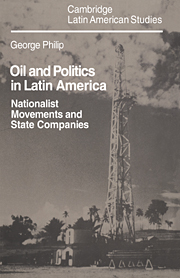Book contents
- Frontmatter
- Contents
- List of tables
- Preface
- Glossary
- Abbreviations
- Note on currencies and other units of measurement
- Maps: Latin America in 1920, 1940, 1960 and 1981; showing importing countries, exporting countries and countries self-sufficient in oil
- Introduction: The politics of oil in twentieth-century Latin America
- Part I The world oil environment
- Part II The major expropriations
- 7 Politics and the concession contract
- 8 Argentina: YPF, Yrigoyen and the 1935 oil law
- 9 Some nationalisations of the 1930s: Chile, Uruguay, Bolivia
- 10 Cárdenas and the Mexican oil nationalisation
- 11 The formation of Petrobrás
- 12 The nationalisation of the ipc in Peru
- 13 The nationalisation of Gulf Oil in Bolivia 1969
- 14 Oil politics in Ecuador 1972–6
- 15 The nationalisation of oil in Venezuela
- 16 Oil companies and governments in twentieth-century Latin America
- Part III The state oil companies
- Notes and bibliography
- Index
- CAMBRIDGE LATIN AMERICAN STUDIES
14 - Oil politics in Ecuador 1972–6
Published online by Cambridge University Press: 23 December 2009
- Frontmatter
- Contents
- List of tables
- Preface
- Glossary
- Abbreviations
- Note on currencies and other units of measurement
- Maps: Latin America in 1920, 1940, 1960 and 1981; showing importing countries, exporting countries and countries self-sufficient in oil
- Introduction: The politics of oil in twentieth-century Latin America
- Part I The world oil environment
- Part II The major expropriations
- 7 Politics and the concession contract
- 8 Argentina: YPF, Yrigoyen and the 1935 oil law
- 9 Some nationalisations of the 1930s: Chile, Uruguay, Bolivia
- 10 Cárdenas and the Mexican oil nationalisation
- 11 The formation of Petrobrás
- 12 The nationalisation of the ipc in Peru
- 13 The nationalisation of Gulf Oil in Bolivia 1969
- 14 Oil politics in Ecuador 1972–6
- 15 The nationalisation of oil in Venezuela
- 16 Oil companies and governments in twentieth-century Latin America
- Part III The state oil companies
- Notes and bibliography
- Index
- CAMBRIDGE LATIN AMERICAN STUDIES
Summary
When the Ecuadorian military took power in February 1972, it found an oil industry which was economically quite well developed but which remained a mystery to almost all Ecuadorians. Ecuador had produced some oil ever since 1918 but the amounts had been small and successive regimes had hardly concerned themselves with oil policy. For many years, Ecuador levied few taxes, had no state company and knew extremely little about the industry. In some ways, therefore, the events of the years 1972–6 may be regarded as providing something of a learning process for Ecuador, after which policy became less dramatic and rather more settled. The 1972–6 period was extremely eventful, both nationally and internationally, and a great deal was telescoped into a very short period of time. Ecuador began large-scale exports of oil in June 1972 and by 1974 the Ecuadorian Oil Minister had become President of OPEC. Only in 1977 did some kind of conservative ‘normality’ return, and this was followed in 1979 by the election of a reformist civilian government.
Expansion and renegotiation 1969–73
The Ecuadorian oil boom got seriously underway in 1967 when a major discovery was made in the Oriente. Until that time Ecuador's smallscale oil production had come entirely from the coastal area; it was widely believed that there was oil to be found in the Oriente but until then no commercially attractive discovery had been made.
- Type
- Chapter
- Information
- Oil and Politics in Latin AmericaNationalist Movements and State Companies, pp. 274 - 292Publisher: Cambridge University PressPrint publication year: 1982



